 |
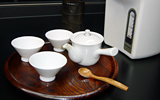 1) Tea set |
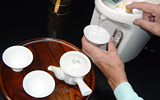 2) Warm up tea bowls and measure the amount of hot water. Pour boiled water into tea bowls for the number of people who have tea. Warming up tea bowls can lower the temperature of hot water and measure the amount of hot water. Once you pour hot water, the temperature of hot water in tea bowls |
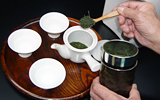 3) Measure the amount of tea leaves. Put tea leaves into a tea pot for the number of people who have tea. |
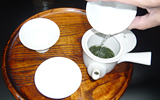 4) Pour the hot water into a tea pot. Pour the hot water in tea bowls into a tea pot. And wait until it infuses. |
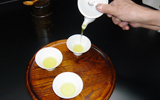 5) Pour.¦1 Pour the tea into each tea bowl little by little from tea bowl to tea bowl, going back and forth evenly to keep the tchickness of tea equal between the tea bowls. |
 6) The last one sip.¦2 Pour out the tea to the last sip. |
 7) Completed. |
¦1 When pouring tea for the number of people, the taste of later poured tea become thick, so pour them into each tea bowl little by little from tea bowl to tea bowl, going back and forth evenly to keep the tchickness of tea equal between the tea bowls.
(If you pour tea from tea bowl number 1, 2 to 3, next is from tea bowl number 3, 2 to 1. Repeat to the last sip.)
¦2 It is said that the last sip has the Umami of tea. Pouring out to the last sip enables you to enjoy delicious tea even in the second cup. Slightly slide the lid of tea pot after pouring out not to steam tea leaves. Pour the second tea upon pouring hot water. These are the standard tea serving, on the other hand, finding your own tea serving by changing the amount of tealeaves, temperature of hot water according to your taste is also a way of enjoying tea serving.
yHow to make Japanese green teaz
yHow to make Matchaz
yTipsz
| ¡Gyokuro Use about 4g of tea leaves for one cup, put about 60 of hot water and pour the tea in one minute. ¦Enjoy the rich flavor and Umami. |
¡Sencha Use about 3g of tea leaves for one cup, put about 70-80 of hot water and pour the tea in one minute. ¦Enjoy the balance among Umami, astringency and bitterness. |
| ¡Deeply steamed powdered tea Use about 3g of tea leaves for one cup, put about 70-80 of hot water and pour the tea in 20-30 seconds. ¦This is a tea which the ingredients of tea can easily be come out. |
¡Hojicha Use about 3g of tea leaves for one cup, put boiled water and pour the tea in about 30 seconds. ¦Enjoy the flavor and mild taste. |
| ¡Matcha Use about 2g of Match in a Matcha tea bowl, power 80-90 of hot water aerating by tea whisk so that it will slightly bubbles. ¦You can take all ingredients containing in the tea as well as Umami. |
¡Reicha (cold tea) Use about 5-6g of tea leaves for one cup, put about 60-70 of hot water, and pour the tea in a glass with ice cubes in about 90 seconds. Take tea on the rocks. ¦The trick is to serving with stronger taste. |
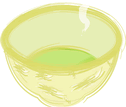
It is the water having a great impact on serving tea. Delicious tea can't be served unless using qualified water. The amount of tea leaves and hot water, the temperature of hot water, the time to infuse and water quality are important to serve tea properly. Once serving tea, most of the component is water so that the quality of water is very important. When the quality of water changes, the taste, flavor and water color will change.
<Water Suitable for Serving Tea>
The water suitable for serving tea is moderate hardness, carbon dioxide, pH and slightly-acid soft water containing a proper balance of minerals and oxygen. Most of the Japanese water is soft water. Therefore, Japanese tap water meets the water conditions suitable for serving tea.
<When Using Tap Water>
Although Japanese tap water meets the water conditions suitable for serving tea, you can't enjoy drinking tea as it is since the tap water contains chlorine. The water will become one suitable for serving tea after fully taking out the chlorine. In order to do so, use it at a proper temperature after boiling more than 5 minutes or storing one night to use. It is better to boil once even in case of using a water purifier.
<Mineral Water>
When using commercial mineral water made in foreign countries, that is not suitable for serving tea as most of them are hard water containing much calcium. (Components of water, such as organic substance, iron, manganese and chlorine influence on the taste, flavor and water color of tea.) Buy one after checking the label out while most of the water made in Japan is soft water.
yThe Reason Why Too Soft Water is Unsuitable for Serving Teaz
If the degree of hardness becomes under 10, people strongly feel the bitterness and astringency when taking tea. That is why it becomes unsuitable for serving tea.
yThe Reason Why Hard Water is Unsuitable for Serving Teaz
The bitterness of tea will be prevented with hard water. This is not suitable for Japanese tea putting emphasis on balancing among bitterness, astringency and Umami.
| Water unsuitable for tea serving. | Influence on tea. |
|---|---|
| Hard water. | The flavor will be weakened, the water color will become cloudy reacting with catechin, and the taste will become lighter. |
| Strong alkaline or acid water. | Strong acid water lightens the water color, while strong alkaline water makes it dark-red. |
| Chlorinated water. | If 0.5mg or over of chlorine is found in 1 liter of water, uncomfortable smell unique to the chlorine will be given off when pouring tea. |
| Saline water. | If about 200mg of salt content is found in 1 liter of water, it will taste salty when pouring tea and the taste will become unbalanced, although astringency will become milder. |
| Water containing iron or manganese. | If 0.4mg of iron or 0.5mg of manganese is found in 1 liter of water, the water color will become blackish brown so that the much manganese is contained the much brownish water color is found. |
¦In Japan, the water containing below 100mg of calcium and magnesium ion in 1 liter of water is regarded as soft water, while the one with 100mg - 300mg is regarded as medium-hard water and the one with 300mg or over is regarded as hard water.
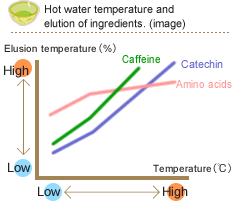
Once the temperature of hot water changes, the taste, flavor, and water color will change.
In order to fully extract tea's potential benefits, it is important to learn the relationships between the temperature of hot water and the ingredients determining the taste of tea.
The number of Amino acid, one of the Umami ingredients, increases as time goes by regardless of temperature.
The number of catechin in astringency, increases with time in higher boiled water, while the number of caffeine in bitter ingredient increases in higher temperature for a short time.
For these reasons, it is one of the pleasures to look for a tea of your choice.
The efficacy of catechinbAnti-oxidation, anticancer, lower blood-cholesterol levels, reduce blood pressure and sugar elevation, antivirus, antibacterial and others.
The efficacy of caffeinebRelieving fatigue, awakening effect, cardiac action, brain stimulation and others.
That is why taking tea like a medicine with boiled water is also good before throwing the used tea leaves.
Tea leaves tend to easily be deteriorated by air, moisture, light and temperature, and absorb odors. Therefore, the depository for tea leaves should be cool and dark, and odorless. Storing in a fridge is also a way of preserving if the package is not opened yet. However, make sure to bring it back to room temperature when opening the package.
This is because tea leaves absorb moisture sticking to the surface of a package if you open before bringing it back to room temperature. After opening, get deflate a package first and keep them at a cool and dark place. Please consume it as soon as possible.



